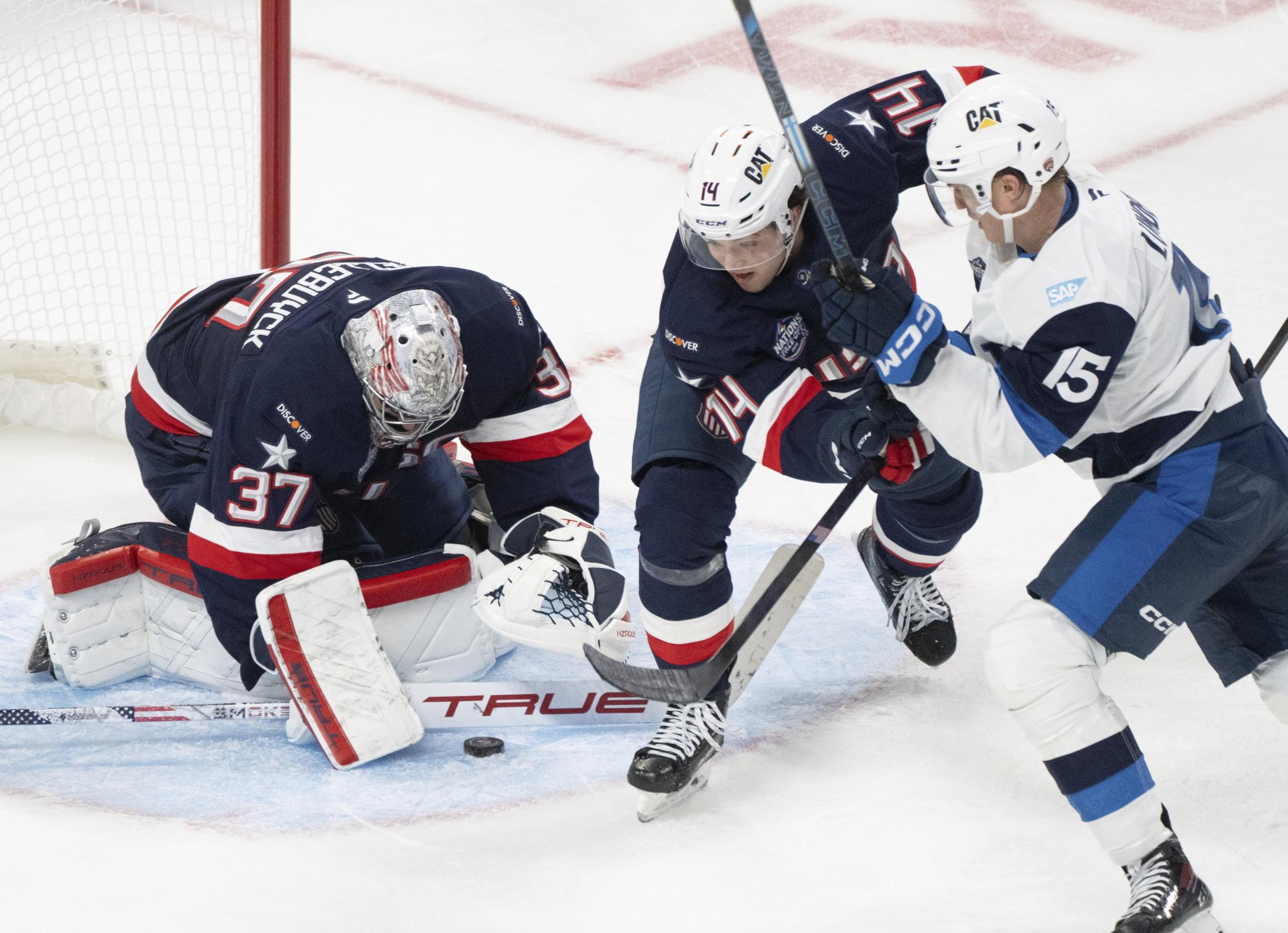Column | NHL’s 4 Nations Face-Off is its best idea in years


United States goaltender Connor Hellebuyck (37) covers up the puck as Finland's Anton Lundell (15) and the U.S.' Brock Faber (14) come in for the rebound during second period in the 4 Nations Face-Off hockey action in Montreal on Thursday, Feb. 13.
When National Hockey League commissioner Gary Bettman first announced the creation of a limited international tournament, the reaction was a bit mixed.
The 4 Nations Face-Off, which features the United States, Canada, Sweden and Finland, was certainly a new and innovative idea — not something the NHL is known for — but no one knew how it would actually play out.
With Bettman holding the NHL and its players out of the Winter Olympics in 2018 and 2022, the sports world had gone nearly a decade since seeing a true best-on-best in men’s hockey. But even with the breath of fresh air that was best-on-best hockey returning, the league was leaving out some of its top talent with the current format.
Setting aside Russia’s complex banishment from international sporting events, David Pastrnak’s Czechia and Leon Draisaitl’s Germany were some countries and players left on the sidelines when the tournament was announced.
In true NHL fashion, the league hindered its own product before it went to air. The league was late in getting any 4 Nations merchandise out to the public, and overpriced tickets for the two locations — Bell Centre in Montreal and TD Garden in Boston — saw slow ticket at the start, setting off some alarm bells for the NHL and the Players’ Association.
However, the biggest concern facing 4 Nations was how competitive and energetic the games would turn out — an issue that has plagued the NHL’s annual All-Star festivities for years.
The modern NHL All-Star Game suffers from a severe case of lethargy, far from the days when Wayne Gretzky and Mario Lemieux would pack the house for an East vs. West All-Star matchup.
There was no better example of that than last season, when Nikita Kucherov made it clear he couldn’t care less as he skated lackadaisically during the passing challenge in Toronto, to a chorus of boos from the fans in the building. The All-Star events are such a non-factor that players are willing to serve suspensions to sit them out, which Alex Ovechkin has done on multiple occasions.
Doubts about 4 Nations’ ability to deliver a better product — and how much players cared about it — crept in when defenseman Alex Pietrangelo withdrew from the tournament for Canada on Jan. 26. Pietrangelo said he wanted to take the time off to prepare physically for the second half of the season. Two hours later, he played over 24 minutes for Vegas, propping up the argument that players didn’t care to compete in 4 Nations.
After all, it was just a precursor to the 2026 Olympic games — where NHL players will participate. Would 4 Nations have any juice?
The answer was a resounding yes.
Pietrangelo was an outlier, and any concerns about 4 Nations failing were settled in the first minute of the tournament’s opening game when Canada’s power-play goal against Sweden blew the roof off of the Bell Centre in Montreal.
The game was electric, with Sweden generating a comeback from trailing 3-1 to force overtime, where Canada ultimately held on for the win. At no point did any player look like they were giving anything less than 100% — which you certainly can’t say about the NHL’s last few All-Star Games.
The U.S. and Finland matched that energy the following night. Both teams got involved in a scrum in the first minute of the game, and the energy remained through the first two periods before the U.S. started to rout the Finns, winning 6-1.
It’s arguable whether the All-Star Game is fixable, but in no All-Star Game would you see Rasmus Dahlin check Connor McDavid to the ice, or Patrik Laine and Joel Eriksson Ek going at it near the benches, or Matthew Tkachuk dropping the gloves with Brandon Hagel at the start of the game.
Well, you might still see Tkachuk do that any time, but you get the point. It’s exhilarating, it’s competitive, it’s genuine hockey — the exact opposite of the recent All-Star Game showings. Aside from the on-ice product excelling, so are the ratings. In addition to netting three million viewers north of the border, Canada vs. Sweden nabbed a million U.S. viewers as well.
The opening American game vs. Finland drew 1.55 million American viewers on ESPN, outdrawing every All-Star Game since 2020 and outperforming the last two Winter Classics. It was the highest NHL-related game since the 2023 Winter Classic, excluding playoff games.
The highlight of the round-robin tournament was Saturday’s game between the U.S. and Canada. Amidst political tensions and the booing of the American anthem in Montreal, three different fights broke out in the first nine seconds of the game, an eventual 3-1 win for the Americans that clinched them a spot in the championship game. The atmosphere rivaled that of a Stanley Cup Final game.
ESPN said the game netted 4.4 million viewers and peaked at 5.2 million, the highest non-Stanley Cup Final viewership in five years. It dominated the social media waves, drawing nearly all attention away from its competition, the NBA All-Star Saturday events. People and pundits who never watch hockey were tuning in to watch this game.
In a day and age where all-star events in all leagues are at an all-time low, the 4 Nations Face-Off has provided a firework show and put the NHL in a very rare position. The NHL has a leg up over the other leagues in North America.
With Canada’s win over Finland on Monday afternoon, the championship will feature a rematch between them and the U.S. on Thursday night in Boston.
Regardless of the outcome of that game, the 4 Nations Face-Off tournament is already an unbelievably successful endeavor for the NHL.
It’s the best thing the NHL has come up with in years.
Recent Posts
Opinion | School should be in the summer
Although this may be controversial, I believe that from this data, it is evident that…
Weathering the storm: Pittsburgh teams have tackled some of the toughest environments
The end of the year in western Pennsylvania is always marked by two things —…
Notes From an Average Girl // Notes on Book Banning
In this edition of Notes From an Average Girl, senior staff writer Madeline Milchman writes…
To Be Honest // Yup, it is that damn phone
In this edition of To Be Honest, staff writer Evin Verbrugge writes about her phone…
Meaning at the Movies | Portraying Toxic ‘Adolescence’
In this edition of Meaning at the Movies, staff writer Lauren Deaton explores the mini-series…
Opinion | Climate change requires radical, immediate action
Contributing editor Emma Hannan talks about the effects of climate change and the actions cities…

